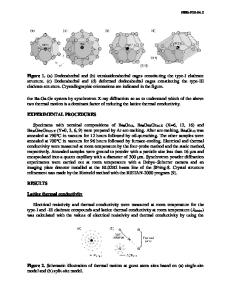Variation in the Einstein Temperature of Guest Atoms in Ba-Ge-X type-III Clathrate Compounds
- PDF / 270,541 Bytes
- 6 Pages / 612 x 792 pts (letter) Page_size
- 41 Downloads / 305 Views
1044-U06-08
Variation in the Einstein Temperature of Guest Atoms in Ba-Ge-X type-III Clathrate Compounds Katsushi Tanaka, Jung-Hwan Kim, Kyosuke Kishida, and Haruyuki Inui Materials Science and Engineering, Kyoto University, Yoshidahon-machi, Sakyo-ku, Kyoto, 606-8501, Japan ABSTRACT Einstein temperatures of guest atoms in Ba-Ge-(Al, In) type-III clathrate compounds have been estimated from the temperature dependence of the atomic displacement parameters determined by synchrotron X-ray powder diffractions. The lowest temperature is obtained for the vibration of Ba(2) atoms along the x-direction, which corresponds to the "rattling motion" of the guest atoms in the compounds. The temperature estimated is significantly low of about 50 K, which agrees with the fact that the compounds have small lattice thermal conductivities of about 0.6 W/mK. Though the lattice thermal conductivity of Ba24Ge88Al12 is larger than that of Ba24Ge88In12, the Einstein temperature of Ba24Ge88Al12 is slightly smaller than that of Ba24Ge88In12. This discrepancy can be explained by the consideration of higher Debye temperature of Ba24Ge88Al12 than that of Ba24Ge88In12, that is, lattice thermal conductivity without "rattling motion" is larger for Ba24Ge88Al12 than that for Ba24Ge88In12. INTRODUCTION Clathrate compounds have been investigated extensively in recent years as promising thermoelectric materials on account of the relatively low electrical resistivity and high Seebeck coefficient in addition to the very low thermal conductivity [1,2]. The crystal structure of clathrate compounds comprises polyhedral cages and guest atoms encapsulated in the cages. The cages consist of group IV and/or III elements, while the guest atoms are typically alkali metals or alkali-earth metals. The “rattling” of guest atoms in oversized cages is considered to scatter heatcarrying phonons efficiently, resulting in low thermal conductivity, while electrical conductivity remains relatively high because electronic conduction mainly takes place through the cage framework [3,4]. Thus, clathrate compounds are considered to behave as “phonon glass-electron crystal (PGEC)". The type-III clathrate structure, formulated as M24(Tr/Tt)100 or M24Tr32Tt68, where Tt and Tr are tetrahedrally and trigonally bonded cage atoms, respectively, is one of the structure types of clathrate compounds considered as possible thermoelectric materials. The compounds are composed of three kinds of cage structures designated pentagonal dodecahedron, open dodecahedron, and distorted cube, as shown in Fig. 1. The encapsulated guest atoms "M(1), M(2), and M(3)" are located, respectively, in 8c, 12d, and 4b sites in the pentagonal dodecahedra, open dodecahedra, and distorted cubes, while the Tt/Tr framework atoms constituting the cage structure are located in six different crystallographic sites [7]. The M(2) atoms located in the 12d site in the open dodecahedra are considered to be the rattling atoms for type-III clathrate compounds, when judged from the anomalously large values of atomic displ
Data Loading...









